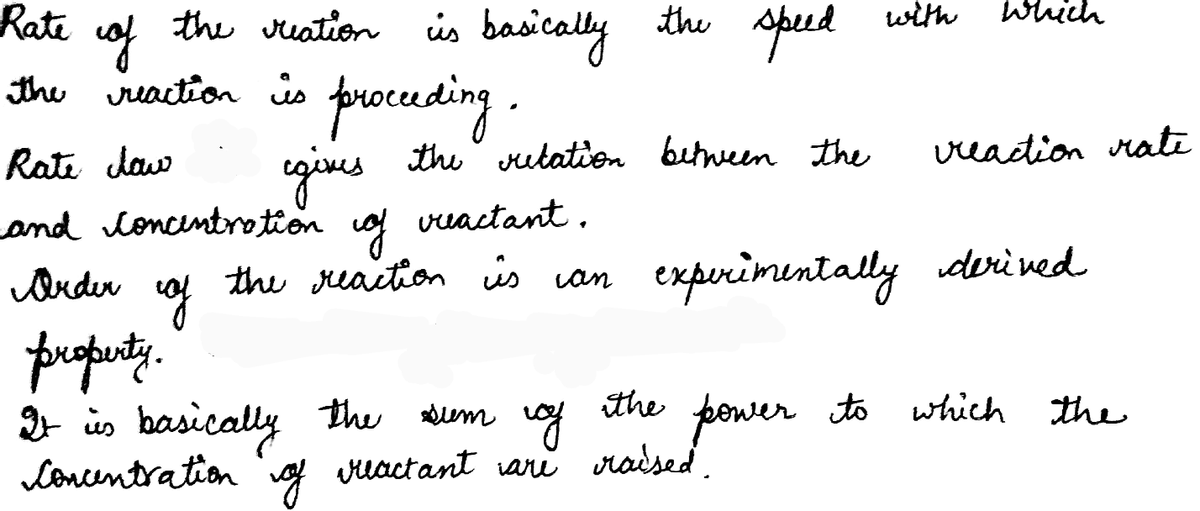
Chemistry
10th Edition
ISBN: 9781305957404
Author: Steven S. Zumdahl, Susan A. Zumdahl, Donald J. DeCoste
Publisher: Cengage Learning
expand_more
expand_more
format_list_bulleted
Question
Consider the following experimental rate data for a general reaction
A + B --> C
Derive the rate law.
| [A] M | [B] M | Rate M/s |
| 0.1 | 0.1 | 0.23 |
| 0.2 | 0.05 | 0.46 |
| 0.2 | 0.1 | 0.92 |
Expert Solution
arrow_forward
Step 1

Step by stepSolved in 5 steps with 6 images

Knowledge Booster
Learn more about
Need a deep-dive on the concept behind this application? Look no further. Learn more about this topic, chemistry and related others by exploring similar questions and additional content below.Similar questions
- Consider the table of data collected for the reaction A → Products. Determine the magnitude (value) of the reaction rate constant by graphing the data appropriately. The table: Time (s) [A] (M) 0.00 0.600 1.50 0.325 3.00 0.178 4.50 0.095 6.00 0.050 7.50 0.028 9.00 0.015arrow_forwardInitial-rate data at a certain temperature is given in the table for the reaction SO₂Cl₂(g) → SO₂(g) + Cl₂ (g) - [SO₂Cl₂], (M) k = 0.100 0.200 0.300 Initial rate (M/s) 2.30 x 10-6 4.60 x 10-6 6.90 x 10-6 Determine the value and units of the rate constant. MacBook Pro units: Question Source: McQuarrie, Rock, And Gallogly 4e - General Chemiarrow_forwardConsider the following reaction. Calculate the rate of reaction for trial 4.. 2 A + B →→ 2 C Trial [A]0 [B]0 [C]0 Rate (M/s) 1 0.28 0.43 0.053 7.668 2 0.56 0.43 0.053 15.336 3 0.28 0.86 0.053 30.672 4 0.77 0.45 0.053 ?arrow_forward
- Consider the reaction I- + OCl- → OH-→ IO- + Cl- Determine the reaction's rate law using the given experimental data. Exp # [I-]o [OCl-]o [OH-]o Initial Rate (M/s) 1 0.0013 0.012 0.10 0.094 2 0.0026 0.012 0.10 0.187 3 0.0013 0.006 0.10 0.047 4 0.0013 0.012 0.20 0.047arrow_forwardⒸ Macmillan Learning Enter these data into the graphing tool and determine the value and units of the rate constant, k, for this reaction. Graphing Tool Add Row 10 total rows [A] [A] vs. t In[A] In[A] vs. t t (min) 0.0 2.0 4.0 6.0 1/[A] vs. t [A] (M) 1.00 0.66 0.43 0.28 1/[A] Clear All Dataarrow_forwardConsider the following fictitious reaction and the measured initial rates at different reaction conditions. Determine the rate law for this reaction. X (g) + y (g) XY (g) Trial 1 2 3 Initial Rate (M/h) 0.05069 [X] M [Y] M 0.1383 0.1860 0.1383 0.6783 0.18476 0.3804 0.1860 0.05079arrow_forward
- Consider the following reaction performed at K and the given concentration and rate data: A products Experiment [A] Rate of reaction (M) (M/s) 1 0.78 0.0026988 2 1.56 0.0053976 3 3.12 0.0107952 First determine the rate law and rate constant. Based on this information; if you set up a new experiment where the [A]. (initial concentration of A) was 1.33 M, what would the concentration of A be after 144 s? [A](M) = number (rtol=0.01, atol=1e-08) ?arrow_forwardGeneral Chemistry 4th Edition McQuarrie • Rock • Gallogly University Science Books presented by Macmillan Learning Initial-rate data at a certain temperature is given in the table for the reaction N,0,(g) NO(g) + NO,(g) [N,O,], (M) Initial rate (M/s) 0.100 0.480 0.200 0.9600 0.300 1.440 Determine the value and units of the rate constant. units: k =arrow_forwardGiven below is the data for the reaction. Calculate the value of the rate constant "k" with proper units. A + B → C Set [A] (M) [B] (M) Init, rate M-sec 1 0.050 0.200 5.0 x 10-5 2. 0.100 0.200 5.0 x 10-5 0.050 0.600 4.5 x 10-4 Determine the order in "A" Determine the order in "B" Substitute the order for A and B in the rate law equation below. Rate = k [A]' [B]arrow_forward
arrow_back_ios
arrow_forward_ios
Recommended textbooks for you
 ChemistryChemistryISBN:9781305957404Author:Steven S. Zumdahl, Susan A. Zumdahl, Donald J. DeCostePublisher:Cengage Learning
ChemistryChemistryISBN:9781305957404Author:Steven S. Zumdahl, Susan A. Zumdahl, Donald J. DeCostePublisher:Cengage Learning ChemistryChemistryISBN:9781259911156Author:Raymond Chang Dr., Jason Overby ProfessorPublisher:McGraw-Hill Education
ChemistryChemistryISBN:9781259911156Author:Raymond Chang Dr., Jason Overby ProfessorPublisher:McGraw-Hill Education Principles of Instrumental AnalysisChemistryISBN:9781305577213Author:Douglas A. Skoog, F. James Holler, Stanley R. CrouchPublisher:Cengage Learning
Principles of Instrumental AnalysisChemistryISBN:9781305577213Author:Douglas A. Skoog, F. James Holler, Stanley R. CrouchPublisher:Cengage Learning Organic ChemistryChemistryISBN:9780078021558Author:Janice Gorzynski Smith Dr.Publisher:McGraw-Hill Education
Organic ChemistryChemistryISBN:9780078021558Author:Janice Gorzynski Smith Dr.Publisher:McGraw-Hill Education Chemistry: Principles and ReactionsChemistryISBN:9781305079373Author:William L. Masterton, Cecile N. HurleyPublisher:Cengage Learning
Chemistry: Principles and ReactionsChemistryISBN:9781305079373Author:William L. Masterton, Cecile N. HurleyPublisher:Cengage Learning Elementary Principles of Chemical Processes, Bind...ChemistryISBN:9781118431221Author:Richard M. Felder, Ronald W. Rousseau, Lisa G. BullardPublisher:WILEY
Elementary Principles of Chemical Processes, Bind...ChemistryISBN:9781118431221Author:Richard M. Felder, Ronald W. Rousseau, Lisa G. BullardPublisher:WILEY

Chemistry
Chemistry
ISBN:9781305957404
Author:Steven S. Zumdahl, Susan A. Zumdahl, Donald J. DeCoste
Publisher:Cengage Learning

Chemistry
Chemistry
ISBN:9781259911156
Author:Raymond Chang Dr., Jason Overby Professor
Publisher:McGraw-Hill Education

Principles of Instrumental Analysis
Chemistry
ISBN:9781305577213
Author:Douglas A. Skoog, F. James Holler, Stanley R. Crouch
Publisher:Cengage Learning

Organic Chemistry
Chemistry
ISBN:9780078021558
Author:Janice Gorzynski Smith Dr.
Publisher:McGraw-Hill Education

Chemistry: Principles and Reactions
Chemistry
ISBN:9781305079373
Author:William L. Masterton, Cecile N. Hurley
Publisher:Cengage Learning

Elementary Principles of Chemical Processes, Bind...
Chemistry
ISBN:9781118431221
Author:Richard M. Felder, Ronald W. Rousseau, Lisa G. Bullard
Publisher:WILEY